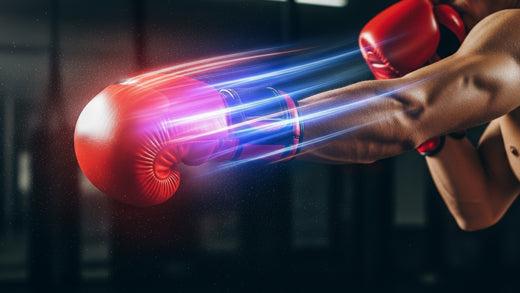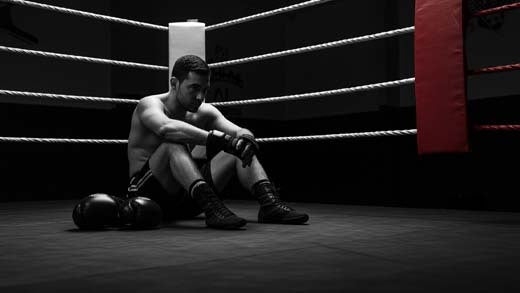The discipline of boxing is based on perseverance, focus, and ongoing self-improvement. The most famous boxers in the world train not just hard but smartly, combining mental toughness, physical accuracy, and technical mastery. Learning how legends hone their techniques can give you a great deal of insight, regardless of your level of experience or readiness for your next sparring session.
We at Sting Sports have examined the training regimens of ten well-known boxers to find lessons that you can use right away to enhance your conditioning, power, and performance in the ring.
Famous Boxers and Their Training Regime
The famous boxers' names mentioned below guided athletes toward perfection through their workout routines, techniques, and diet.
1. Mike Tyson
Mike Tyson holds the title of the youngest champion in boxing history, and he’s had one of the most controversial yet successful careers. His daily training includes:
-
Cardio: Early morning runs (3–6 miles) were followed by intense interval sprints.
-
Drills and Sparring: Tyson would go to the gym by 10 am, performing drills and sparring for about ten rounds.
-
Strength and Conditioning: Tyson’s strength and conditioning started at around 5 pm, consisting of callisthenics. He would perform 500 shrugs with a loaded barbell, 500 push-ups, 2,500 sit-ups, 2,000 bodyweight squats, and 800 dips.
-
Nutrition: Tyson maintained a high-calorie diet (3,000–4,000 calories), consisting of steak or chicken with rice or pasta, rich in complex carbohydrates to fuel his intense training schedule.
Lesson: Functional strength demands rotational movement. Prioritize high-volume bodyweight circuits to build the core and leg power needed for explosive, short-range strikes.
2. Muhammad Ali
Ali's strategy centred around speed and movement, turning defence into offence. His footwork was unparalleled among heavyweights due to focused repetition and rhythmic training.
-
Cardio: Ali performed daily 5-6 mile runs to develop stamina and discipline, before extensive jump rope work to master his boxing stance and develop light, rhythmic footwork
-
Drills and Sparring: He would start his real training in the gym around 12.30 pm to 3.30 pm with shadowboxing to master his movements and “Dancing Jab. This was followed by sparring with the training partners and then a 20-minute jump rope exercise.
-
Strength/Conditioning: To train his strength, he relied on bodyweight exercises such as push-ups and sit-ups to develop his core strength and muscular endurance without the need for heavy lifting, as it slows down his speed.
-
Nutrition: He incorporated lean meat, vegetables, fruits, and water into his daily life to stay energetic during training and competition.
Lesson: Conditioning is Footwork. Train in rope jumping to build rhythm and agility, and engage in boxing training to stay light on your feet.
3. Manny Pacquiao:
Pacquiao's dominance across eight divisions required unparalleled stamina and output both inside the boxing ring and on the road.
-
Cardio: His cardio workout consisted of long-distance running, covering eight miles, combined with intense interval sprints to complement his aerobic base with the anaerobic bursts required to execute large volume combinations.
-
Drills and Sparring: Pacquiao would train for one to two hours, honing his skills under constant pressure by hitting high round counts on mitts, speed bags and heavy bags.
-
Strength and Conditioning: He utilized both conventional weight lifting (squats and deadlifts) as well as plyometrics (jumping off boxes) in order to make sure his strength directly applied to punch power and speed.
-
Diet: Pacquiao follows a regulated diet rich in protein, complex carbohydrates, and healthy fats. High-volume, multi-session days did not compromise his consistency in fueling his body.
Lesson: Maximize output with plyometrics. Integrate explosive strength exercises into your boxer workout to maintain speed and punch volume late in a session.
4. Lennox Lewis:
Lewis became one of the most famous Canadian boxers by successfully combining technical boxing skills with modern athletic conditioning to maximize his size and reach advantage.
-
Cardio: To build overall cardiovascular health and stamina, Lewis integrated long runs, swimming, rowing, skipping routines and cycling to foster overall cardiovascular fitness and stamina.
-
Drills and Sparring: He developed an impressive piston-like jab while devoting much of his training to precision mitt work. Sparring was strategic, focused on neutralizing any of an opponent's strengths.
-
Strength and Conditioning: He implemented heavy compound lifts (squats, deadlifts) into his workout routine to strengthen his defence while amplifying punch force; an approach now common among large fighters.
-
Nutrition: Lewis followed an extremely well-balanced diet composed of lean meats, eggs, fruits and whole grains for protein, complex carbs and fats.
Lesson: Strength is key to any effective defence. Aim to build strength through compound lifts and Strength Training Equipment while simultaneously engaging in mobility drills for enhanced reach.
5. Canelo Álvarez:
Canelo has secured titles in four divisions at this point in his career, and he’s been the biggest name in boxing since Mayweather and Pacquiao.
Here’s what his training routine looks like:
-
Cardio: Canelo spends about an hour running as much as five miles on training days to prepare his legs for 12-round fights.
-
Strength and Conditioning: Alvarez performs full-body workouts 3 times a week during his camps. These sessions typically include weight training and high-intensity interval training. He often finishes his workout sessions with bodyweight exercises that target the core.
-
Drills and Sparring: He aims to spar for about 30 minutes to an hour during training days. He often works on his skills with heavy bags, mitts, and speed bags before entering the ring.
-
Nutrition: Canelo Alvarez's diet is strict and focused on lean protein, fruits, and vegetables, with variations depending on the training phase. During a fight camp, his diet consists of around 1700 calories split into six meals.
Lesson: Maximum strength demands periodization. Mix heavy, full-body weightlifting with plyometrics to ensure your raw power translates into dynamic, fight-ending punches.
6. George Foreman:
Foreman's philosophy revolved around incredible raw power to quickly end fights. His system prioritized building unparalleled raw strength and resilience.
-
Cardio: His cardio routine consisted of long roadwork sessions designed to build core durability and stamina. He often employed manual labour, such as chopping wood, as part of his functional strength endurance routine.
-
Drills and Sparring: Foreman focused his drills and sparring sessions on full-power strikes on a punching bag, while sparring sessions emphasized continuous forward pressure and body conditioning.
-
Strength and Conditioning: Training focused on hitting a heavy bag relentlessly and performing high-rep callisthenics exercises with increasing reps to build structural integrity to withstand and deliver massive force.
-
Nutrition: George Foreman's training diet focused on low-fat proteins, lean meats, vegetables, and fruit. Breakfast typically consisted of egg whites on toast with jelly, while post-workout meals included broiled lamb chops or steamed vegetables.
Lesson: Committing to raw power requires structural stability. Focusing on heavy striking and neck/core conditioning exercises will build the base required to absorb and deliver fight-ending force.
7. Rocky Marciano:
Marciano retired undefeated, achieved through overwhelming aggression and durability that rendered his opponents powerless against him.
-
Cardio: His cardio routine consisted of extensive roadwork and high-volume conditioning circuits to maintain pressure until his opponent was exhausted.
-
Drills and Sparring: Marciano utilized bag work to refine his relentless forward attack style, while sparring prepared him to absorb punishment while still executing his attack plan.
-
Strength and Conditioning: His workout involved callisthenics and functional exercises designed to maximize muscular endurance, with particular attention paid to strengthening neck and core areas in order to prolong durability.
-
Nutrition: Marciano maintained a simple yet disciplined diet consisting of essential, wholesome foods to fuel his rigorous work rate throughout long camps.
Lesson: Conditioning equals dominance. Use endurance training (such as long roadwork sessions) as a psychological weapon to maintain pressure and stamina when your opponent becomes fatigued.
8. Joe Frazier:
"Smokin' Joe" was one of the world's most famous boxers, renowned for exerting constant, relentless pressure and a fight-ending left hook.
-
Cardio: His regimen included extensive road work at an even pace, skipping to keep constant pressure during later rounds.
-
Drills and Sparring: Frazier frequently used bobbing and weaving drills to narrow the distance effectively, while his sparring focused on staying close and landing devastating short-range hooks.
-
Strength and Conditioning: Training focused on strengthening his core and legs for short-range hooks
-
Nutrition: His diet included high-calorie foods to fuel his aggressive fighting style and promote muscle recovery.
Lesson: Master the inside game. Prepare your body and legs to power short-range hooks while continuously practicing bobbing and weaving to close in on taller opponents safely.
9. Floyd Mayweather Jr:
Mayweather achieved success through defensive mastery, ring intelligence and consistent training that enabled him to dictate the pace of each fight he participated in.
-
Cardio: Mayweather begins his day with a five to six-mile morning run, typically beginning around 3 am, to establish and maintain an aerobic base. Running has become such an integral part of his lifestyle that his team often brings his running gear with them wherever he travels.
-
Drills and Sparring: He spends many hours at the gym engaging in drills and sparring sessions based on specific defensive drills and timing exercises.
-
Strength and Conditioning: Mayweather takes an unconventional approach to his strength training: instead of breaking up skill drills into three-minute rounds, he prefers spending up to twenty minutes nonstop at each drill station.
-
Nutrition: Floyd Mayweather travels with his own private chef and enjoys meals that are balanced and rich in protein, with careful nutrient timing to maximize energy levels and recovery during technical drills.
Lesson: Your defence should always come first. Set dedicated training time to develop these essential abilities. Focus on timing drills and performing the Boxing technique of shoulder roll when working on defensive skills.
10. Katie Taylor:
Taylor represents the modern blueprint, transitioning from Olympic gold to undisputed professional status by combining relentless conditioning with technical perfection. She is one of the greatest Female Boxers of All Time.
-
Cardio: Her Cardio includes high-volume road work and intense interval training, allowing her to deploy relentless pressure without burning out in professional rounds.
-
Drills and Sparring: She will spar around 3 times a week during training camp. She'll go all the way up to 12 rounds. She's never afraid of taking on someone new in a sparring session to test out her boxing IQ.
-
Strength and Conditioning: Taylor’s training is balanced, integrating strength work with technical drills to maintain her agility and speed. Her routines are designed to meet the functional fitness requirements of the boxer workout.
-
Nutrition: During training camp, she typically eats porridge with berries and fruit in the mornings. Between sessions, some carbs and protein. Salmon and chicken are her go-to protein sources. She eats regular, three meals a day, following a strict, disciplined diet.
Lesson: Discipline fuels longevity. Maintain a high-volume regimen that balances agility, strength, and technical precision to ensure you sustain elite pressure without burning out.
Sting Sports Training Gear
To train like these top boxers, it takes the right equipment. Sting Sports provides essential gear that supports every stage of your boxing journey.
|
Training Focus |
Gear You Need |
Why It Matters |
|
Power & Speed |
Sting Viper Pro Gloves |
Give balance between power and precision for pad work or sparring. |
|
Endurance & Conditioning |
Sting Heavy Bag |
Improves punching rhythm and increases strength and endurance. |
|
Footwork & Agility |
Sting Pro Jump Rope |
Enhance cardiovascular fitness and coordination. |
|
Strength & Core Stability |
Sting Weight Bag Set |
Add resistance to develop explosive power and maintain balance. |
|
Protection & Comfort |
Sting Head Guard & Mouth Guard |
keeps your focus and confidence while ensuring safety during intense sparring sessions. |
The Takeaway
These most famous boxers have achieved success without cutting corners. Their road maps indicate that through disciplined and regular actions, and by building a small daily habit, we can achieve remarkable outcomes.
The professional equipment that Sting Sports offers provides optimal protection and durability for all your training needs. These professional boxing tips and blueprints from the legends will help you make your current workout a Process of becoming a Champion.
FAQs
Q1. Which type of training do famous boxers focus on?
The majority of the renowned boxers ensure to incorporate a combination of cardio, strength training, and technical training.
Q2. Who are the famous Canadian boxers who are known for their discipline in their training?
Among the most renowned boxers in Canada who are famous due to their well-organized, high-intensity training programs are Lennox Lewis and Jean Pascal.
Q3. How often should the professional boxer train?
Five or six days a week can give fighters a balance between technical training, cardio, and rest days to ensure maximum recovery and performance.




